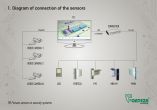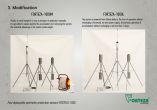Next - generation microwave monostatic sensors FM
- Written by Forteza Russia
- Published in Physical Security
The engineers of the company OOO Okhrannaya technika (Russia) (trademark Forteza) produced a unique device pretended to be named nowadays as the most reliable microwave monostatic sensor.
The radars and the microwave monostatic sensors have the same theoretical basis and probably the release date.
The first Russian security sensor created by the beginning of the Second World War was the planes detector RUS-1. It detected the plane’s fly through the controlled air zone.
Nowadays the radars and the radio navigation systems have a lot of performance capacities.
There are some sensors intended for the circular and perimeter monitoring, territory protection which are able to detect and control one or some targets at the distance up to 1 km.
But all the microwave intrusion sensors or radars have their developmental history.
The principle of all the sensors is based on the Doppler Effect. As for the microwave sensors application, this is the frequency and phase shift of the reflected signal from a target in relation to the transmitting one. This shift depends on the moving target speed and its range from the transmitter.
The first radars used a continuous single-frequency signal and had frequency changer to obtain Doppler frequency, difference frequency filter, the detector and the threshold execution unit.
Nowadays this Doppler principle is applied successfully in some inexpensive sensors for simple applications. OOO Okhrannaya technika (trademark Forteza) also produces “simple Doppler sensors” named as FANTOM operating as S - and X - bands. These next generation sensors have the pressure cases and modifications via RS-485 interface. They can decide any local problem protecting rooms and separate perimeter sites.
In these sensors a signal level provoked by an intruder depends highly on the distance. The sensor should have its own detection sensitivity for every distance which can be changed up to 80 dB and more. That’s why the designers of the company OOO Okhrannaya technika (trademark Forteza) decided to equalize the monostatic sensors sensitivity along the detection zone.
The radars development allowed applying multi frequency and multiple signals, and solving the protection problem and dedicating a necessary signal.
The result of such researches was the sensor SP4U40, popular not only in Russia but abroad too. It allowed applying the radar detection method in some difficult interference conditions and made a good showing thanks to its many years’ service. Many Russian producers of microwave monostatic sensors use the similar technical solutions as SP4U40.
But the modern requirements to these technical solutions are higher than their technical capabilities. As for some difficult perimeter sites, if it is necessary to limit the detection zone length and to detect a target more exactly in some interference conditions, the sensors of this category operate unstably or not applicable.
The parallel development received a principle based on the application of two transmitting signals by turns with different frequencies and phases, and the Doppler signals processing after the two-channel synchronized receipt.
Particularly, the popular American company Southwest Microwave presented its new sensor Model 385. It can limit the operation range very exactly. This technology is named as “Range Cut-Off”. Also it separates the nearest zone and sets low detection sensitivity to reduce some noises level. The sensitivity in the rest “not cut-off” zone is regular and high.
The expensive sensor Model 385 has very high climatic protection (operation at 100% humidity), solid construction (total weight with the bracket is 4,5 kg) but a low limit of temperature is - 35˚C.
The radar Murena produced by the popular Italian company CIAS in 2008 has the same functions. The producer uses so called “fuzzy logic” in the sensor’s algorithm and compares the signals with the images memory.
Both sensors are the next-generation ones of these companies and differ from the sensors of the category SP4U40 only by the best price.
However it is more effective to generate the detection zone flexibly with the minimum discreteness changing the detection sensitivity along the zone. If interference is not removed, e.g. in the middle of the zone, you can reduce the detection sensitivity in the perimeter site or disconnect it. In this case it is possible to disconnect not only some far separate sites with moving traffic but to generate the rest part of the detection zone for the necessary object without any preliminary preparation, and to disconnect the nearest part only if necessary.
These functions were just performed in the new sensor FM produced by the company OOO Okhrannaya technika (trademark Forteza).
This sensor is produced by series, sold well and receives only positive testimonials.
That’s why nowadays we can say directly about the next-generation technical solutions and high quality of the sensor FM.
The ranging signal with difficult frequency modulation and line spectrum of the combined signal including Doppler specifications are applied in the sensor. These specifications depend on the distance from the point of emanation to the space equally-spaced positions limited by the detection zone.
In this case the signal processing algorithm including digital filtering with quick-operating signaling processor application and intellectual processing allows separating exactly a necessary signal provoked by a moving target in some interference conditions: weather, false small targets, relief irregularity, factory interference and electromagnetic emission.
The detection zone in this sensor is divided into many subzones (sites). Every subzone is a separate security sensor of its particular site in the detection zone. Every subzone-sensor received the possibility to set its detection sensitivity, amplification and the operating threshold. In real conditions it is performed over PC or the control room over RS-485 interface, and you can disconnect the subzones and set the total sensitivity by the hand-operated controls located under the hermetic cover.
This is the basic detection technology of the microwave monostatic sensors FM.
It should be noted that the radars Model 385 and Murena having three operated sites are limited considerably in the functions specified above as the Russian sensors well.
Let’s see the basic functions of the sensor FM with its unique specifications.
Using PC you can connect to the sensor over USB or RS-485 interface, see the signals in every subzone, check some interference level and perform the preliminary sensitivity adjustment.
With some control passages you can adjust the sensor along the detection zone and determine the subzones position.
Then you can limit exactly the detection range and eliminate completely any interference outside the zone (transport, pedestrians, quay, etc.).
You can change considerably the detection sensitivity situated near to the sensor and eliminate all interference from small targets (birds, garbage, etc.) saving the detection ability. If there is a lot of interferences, you can disconnect the nearest subzone.
Thanks to ANTIMASKING function any sabotage attempts are eliminated.
But you can reduce considerably the sensitivity (or disconnect it) in one or some adjacent subzones located in the place where there is interference, e.g. your favorite plant. So, there are a lot of such zones of all not only in the beginning or the end of the detection zone. But in all the rest subzones the rated sensitivity and the necessary detection ability will be saved.
Disconnecting some subzones you can organize some permanent or temporary “approved” passages, e.g. for guard personnel or traffic way.
You can leave only one or some active (connected) subzones (if necessary) and block the appointed perimeter site without paying attention to any objects outside, e.g. the exit point protection through some pipes overtopping the fence without using the barbed wire.
If your perimeter site has a difficult configuration and comprises some deep and narrow sites, blind alleys, hollows, corner buildings, and you cannot solve this problem simply and cheaply applying the microwave sensors, use the sensors FM on these perimeter sites.
The sensor can protect not only the entire perimeter site but a separate place, e.g. warehousing goods if you direct the sensor from top downward and connect only the subzones where the goods are located. Using a Doppler sensor some birds flying above the goods will influence on the sensor operation. In the case with the sensor FM, it is not possible of all.
If you order the sensors FM of the zone configurations “CURTAIN” or “FAN”, you can protect outside and inside walls of buildings, hangars walls, warehouses, windows, doors, gates, ceiling and storage. In this case some special configurations of the detection zone reduce the re-reflection from the objects surfaces and false alarms quantity.
If the configuration of your perimeter site is difficult and you need some sensors for protection, these barriers can influence each on other. But you can use the modifications of the sensors FM with four frequency letters. This sensor decides such problems very successfully.
The radars Model 385 and Murena operate on the different frequencies like as K- and X- bands. The sensor FM is offered to a customer in two modifications with the different frequencies according to the ranges but with the same performance specifications. The sensors FM of the frequency 24 GHz (K-band) have the index “24”. The sensors without this index operate on X-band.
Using the convenient graphic interface you can set the necessary software from a laptop through USB cable and adjust the sensor after its mounting or during its exploitation. The software is situated in our Website www.FORTEZA-EU.com. Don’t hesitate to contact our customers managers for the software request.
The sensor has high performance specifications, operates at the temperature -40…+75˚C, intended for outdoors application and has the explosion-proof enclosure.
As we have already said, the sensor has the interface RS-485 and can be integrated with other security systems operating over RS-485 interface and protocol.
In our specialists’ opinion, a lot of technical solutions applied in the device are unique. That’s why OOO Okhrannaya technika (trademark Forteza) sent the patent request. This request is accepted and is passing some tests now.
The detection zone is divided into some subzones and signals generation provoked by every subzone allowed using the sensor as a distributed monitoring and security device. It informs us about any intruder’s penetration in the subzones, e.g. the subzone range is about 2,5 m. Thanks to RS-485 interface operation, the sensor indicates an exact place where an intruder penetrated. After that you can mount there video cameras, spotlights, etc. Please note all the address sensors are invisible and are present along the perimeter line without any physical fence requirements.
We have checked this capacity with one of our partners who is designing some integrated security systems. The test results are good. Our company is ready to cooperate with the integrators.
Over the last years the dual-technology sensors of foreign manufacture become more popular. They combine two detection physical principles in one case (IR+MW). The logic “I” application increases the interference immunity at the maximum sensitivity application.
Usually most popular sensors combine a usual radar and infrared moving detector (PIR-sensor) and they are used as some signaling systems.
The engineers of the company OOO Okhrannaya technika (trademark Forteza) produced the most effective dual-technology sensor including a next-generation microwave sensor FM and a reliable infrared security module. These sensors are named as MIR-M30.
The logic “I” is a basic signal processing one in the sensors MIR-M30. But at customer’s option a preliminary alarm can be transmitted by one of the detection channels response. The signals transmission over RS-485 interface gives a possibility to choose the operation logic.
The latest design versions are performed at customer’s order.
It allowed combining high interference immunity and adaptive capabilities of the sensor FM thanks to its dual-technology. As a result the high reliable dual-technology sensor was created not having any world technical analogues.
According to the test results our partners wrote the testimonials of the sensors FM and MIR-M30 operation. You can request them from our customers’ managers.
All the above-mentioned allows saying that we really produced a unique device pretending to be named as the most effective microwave monostatic sensor.
In conclusion we’d like to note the performance possibilities of the sensors FM and other ones using this unique technology are not completely exhausted. We are planning to increase the subzones quantity, to improve the processing algorithm and others. But all the basic above - described capacities are included in the sensors FM-30, FM-60, FM-30 (24) and FM-60 (24).









